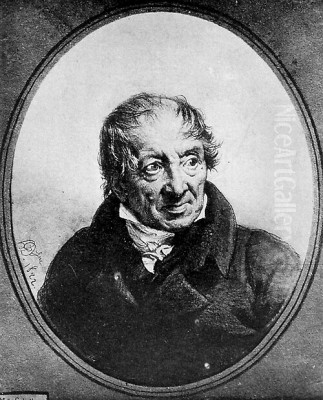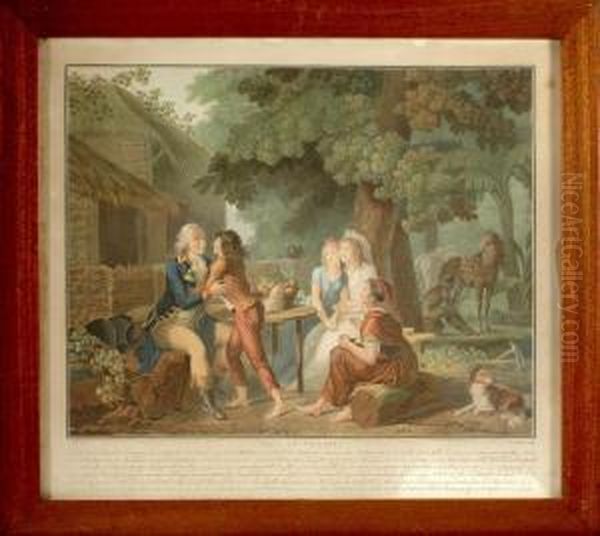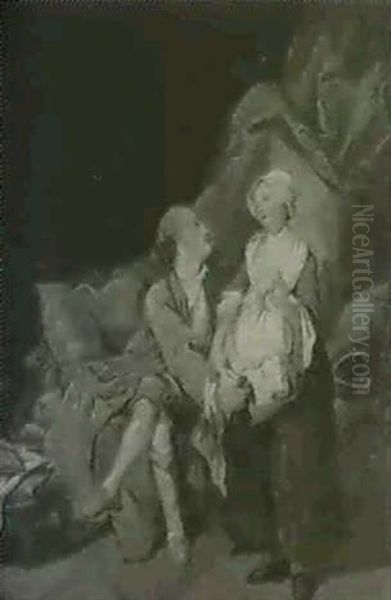
Jean-Frédéric Schall stands as a fascinating figure in late 18th and early 19th-century French art. Born in Strasbourg in 1752 and passing away in Paris in 1825, his life and career spanned a period of immense social and artistic upheaval, from the twilight of the Ancien Régime through the French Revolution and into the Napoleonic era. Primarily associated with the Rococo style, Schall specialized in capturing the elegance, intimacy, and often the underlying sensuality of his time, leaving behind a body of work celebrated for its delicate execution and charming subject matter.
Early Life and Artistic Formation
Schall's artistic journey began in his native Strasbourg, a city with its own rich artistic traditions, situated at a cultural crossroads between France and the Germanic lands. Around 1768, he received his initial training at the city's public drawing school, demonstrating an early aptitude for the visual arts. Seeking to further his talents, he made the pivotal move to Paris, the undisputed center of the European art world, in 1772.
In Paris, Schall gained admission to the prestigious École royale des élèves protégés (Royal School for Protected Students). This institution was designed to nurture promising young artists under the direct patronage of the Crown, preparing them for potential entry into the Académie Royale de Peinture et de Sculpture. Here, Schall had the significant opportunity to study under the guidance of Nicolas-Bernard Lépicié (1735-1784), a respected painter known for his historical subjects and sensitive genre scenes. Lépicié's tutelage undoubtedly provided Schall with a solid grounding in academic principles, drawing, and painting techniques.

While Schall successfully completed his studies at the École royale, sources indicate he did not formally become a member of the Académie Royale itself. This distinction, however, did not impede his ability to build a successful career. His training under Lépicié, and potentially exposure to other Parisian masters and the vibrant artistic milieu of the capital, equipped him with the skills necessary to navigate the competitive art market. Some accounts suggest possible guidance from figures like Jean-Baptiste-Henri Deshays or perhaps Jean-Baptiste Le Prince, further broadening his early influences, though Lépicié remains his most clearly documented mentor.
Embracing the Rococo Spirit: The Fête Galante and Intimate Scenes
Schall entered the Parisian art scene during the latter stages of the Rococo period. While the grand historical narratives favored by the Académie held sway, there was also a strong market, particularly among private patrons, for smaller, more intimate works that celebrated pleasure, elegance, and charm. Schall excelled in this domain, becoming particularly known for his contributions to the fête galante genre.
Pioneered earlier in the century by Antoine Watteau (1684-1721), the fête galante depicted idyllic outdoor gatherings, often featuring elegantly dressed figures engaged in courtship, music, and leisurely pursuits. Schall adapted this tradition, infusing it with the slightly more explicit sensibility characteristic of the later Rococo. His works often feature dancers, actors, fashionable members of the aristocracy, and their companions, set against lush garden backdrops or within opulent interiors.
His style resonated with the tastes of the era, finding favor among the upper classes and collectors who appreciated the refinement and lightheartedness of his canvases. Influences from established Rococo masters are evident in his work. The playful sensuality and decorative flair of François Boucher (1703-1770) can be discerned, as can the fluid brushwork and intimate charm found in the paintings of Jean-Honoré Fragonard (1732-1806). Schall also seems to have absorbed lessons from specialists in gallant scenes like Pierre-Antoine Baudouin (1723-1769), Boucher's son-in-law, known for his suggestive interior subjects, and perhaps the elegant genre painter Jean-François de Troy (1679-1752).
Schall's early success was built upon his ability to capture the atmosphere of sophisticated sociability. His paintings often depict balls, banquets, musical interludes, and private moments, rendered with meticulous attention to the details of fashion, furnishings, and décor. This focus on the material culture of the elite further enhanced the appeal of his work to his clientele.
Artistic Style and Technical Finesse

Jean-Frédéric Schall developed a distinctive artistic style characterized by delicacy, refinement, and a masterful handling of light and color. His brushwork is typically fluid and graceful, avoiding harsh lines in favor of soft contours and subtle transitions. He employed a palette often rich in pastel shades, contributing to the overall lightness and charm of his compositions. Light plays a crucial role, often soft and diffused, enhancing the intimacy of interior scenes or lending a dreamy quality to outdoor settings.
Compared to the sometimes-vigorous energy of Fragonard, Schall's touch can appear more consistently delicate and polished. His figures, often youthful and idealized, possess a certain porcelain-like quality. He excelled at rendering textures, particularly the silks, satins, and lace of fashionable attire, which added to the luxurious appeal of his paintings.
While firmly rooted in the Rococo aesthetic, Schall's work occasionally hints at the burgeoning sensibilities of Neoclassicism and early Romanticism, particularly in his later mythological or historical pieces. However, his primary mode remained one of graceful elegance. His compositions are typically well-balanced, often focusing on small groups of figures within carefully constructed settings. He managed to convey narrative and emotion through gesture and expression, albeit within the somewhat restrained conventions of gallant painting.
His technical skill extended beyond oil painting. Schall's compositions were popular sources for engravers, allowing his imagery to reach a wider audience. Furthermore, evidence suggests his involvement or influence in decorative arts, such as verre églomisé (glass painting), demonstrating the versatility and appeal of his designs across different media.
Predominant Themes: Gallantry, Mythology, and Portraiture
Schall's oeuvre revolves around several key themes, often overlapping and reflecting the tastes of his patrons. The most prominent is undoubtedly the world of gallantry and sophisticated leisure. His fêtes galantes and intimate interior scenes capture the essence of aristocratic sociability, focusing on themes of courtship, music, dance, and conversation. These works often carry a subtle, and sometimes not-so-subtle, erotic charge, depicting moments of flirtation, stolen glances, and amorous encounters.
Mythology provided another fertile ground for Schall's imagination, particularly as a vehicle for depicting the female nude, a subject highly favored in the Rococo era. He often painted scenes featuring Venus, Cupid, nymphs, and satyrs, typically set within idyllic pastoral landscapes. These mythological subjects allowed for a degree of sensuality that might have been deemed less acceptable in straightforward genre scenes, cloaking eroticism in the guise of classical allegory. Works like The Triumph of Love exemplify this aspect of his production, blending mythological narrative with Rococo charm.
While primarily known for genre and mythological scenes, Schall also undertook portraiture. One notable example is L'Attente (The Wait), believed to be a portrait of Pauline Boyer, painted around 1800-1802. This work showcases his ability to capture individual likeness while retaining his characteristic elegance and sensitivity. His portraits often blend seamlessly with his genre work, depicting sitters within intimate, fashionable settings.
A significant portion of Schall's output appears to have been created for private collectors, sometimes referred to euphemistically as works for "cabinets." These pieces often pushed the boundaries of decorum, featuring more explicitly libertine or erotic themes. While sometimes controversial, these works reflect a specific facet of late Ancien Régime taste, where private art collections could explore subjects deemed unsuitable for public display. The demand for such imagery highlights the complex relationship between art, patronage, and morality during the period.
He also depicted scenes inspired by popular literature, such as the story of Paul et Virginie, Bernardin de Saint-Pierre's immensely successful novel. These works tapped into the sentimental currents of the time, blending exoticism, romance, and pathos.
Navigating the Revolution and Beyond
The French Revolution, beginning in 1789, profoundly impacted French society and its artistic landscape. The patronage system shifted, and artistic themes began to reflect the new political realities and republican ideals. Like many artists of his generation, Schall had to adapt. During the height of the Revolution, there appears to be a noticeable shift in his subject matter.
He turned towards more serious themes, including historical and patriotic subjects. Some sources mention works like The Heroism of William Tell or Lacombe Saint Michel Liberating Ligurian Prisoners in Tunis (the exact subjects and attributions sometimes require careful verification) as examples of this period. The depiction of historical events or allegories celebrating republican virtues became more common. His continued use of mythology during this time might also be interpreted, in part, as a way to continue depicting favored subjects like the nude while framing them within acceptable allegorical or historical contexts.
However, Schall's fundamental artistic inclinations remained tied to elegance and charm. As the political climate stabilized under the Directory and later the Empire, he largely returned to the mythological and gallant themes that had defined his earlier success. His ability to navigate these turbulent years suggests a degree of pragmatism and adaptability. Unlike artists like Jacques-Louis David (1748-1825), whose career was deeply intertwined with revolutionary and Napoleonic politics, Schall seems to have maintained a more independent path, catering to a persistent taste for refinement and pleasure.
Exhibitions, Recognition, and Market Presence
Despite not being a member of the Académie Royale, Schall sought recognition through public exhibitions. He participated in the Paris Salons, the official art exhibitions that were crucial for an artist's reputation and commercial success. Records indicate he exhibited works at the Salons of 1793, 1798, and 1806 (and possibly 1799).
His submissions were generally well-received, and critics sometimes compared his style favorably to that of Antoine Watteau, acknowledging his mastery of the fête galante tradition. This comparison highlights his perceived position as a significant inheritor and continuer of the Rococo spirit in the genre of elegant sociability.
Schall's works found their way into prominent collections, both during his lifetime and posthumously. Patrons included members of the aristocracy and the wealthy bourgeoisie. His paintings were traded on the art market, appearing in auctions in Paris and Versailles. The collector Alfred Beurdeley, for instance, is known to have owned Schall's The Triumph of Love. The presence of his works in such collections and sales attests to his established reputation and the desirability of his art.
A challenge in studying Schall's oeuvre is that many of his earlier works were unsigned. Over time, art historians have worked to attribute unsigned paintings to him based on stylistic analysis, leading to a fuller understanding of his output. Today, his paintings are held in various public collections, including the Musée du Louvre in Paris and museums in his native Strasbourg, as well as potentially the Villa Ephrussi de Rothschild and other international institutions, confirming his lasting significance.
Schall in the Context of his Contemporaries
To fully appreciate Jean-Frédéric Schall's contribution, it is essential to view him alongside his contemporaries. His artistic lineage clearly connects back to the great Rococo masters Watteau, Boucher, and Fragonard. He shared with them a dedication to themes of love, leisure, and beauty, executed with technical brilliance and decorative sensibility.
He operated in a similar sphere to artists like Pierre-Antoine Baudouin and Philibert-Louis Debucourt (1755-1832), who also specialized in gallant and genre scenes, often with moralizing or satirical undertones. Debucourt, in particular, became renowned for his color prints depicting Parisian society. Schall's work, while sharing thematic similarities, often maintained a softer, more idealized focus compared to the sometimes sharper social commentary found in Debucourt or the moral dramas of Jean-Baptiste Greuze (1725-1805).
His career overlapped with the rise of Neoclassicism, championed by Jacques-Louis David. While Schall adapted somewhat during the Revolution, his core aesthetic remained distinct from the severity, heroic scale, and classical rigor of Davidian Neoclassicism. He represents a continuation of an alternative artistic current that persisted alongside the dominant Neoclassical style.
Other notable contemporaries include Élisabeth Vigée Le Brun (1755-1842), famous for her elegant portraits of the aristocracy, particularly Queen Marie Antoinette, and Louis-Léopold Boilly (1761-1845), a meticulous painter of Parisian life and portraits. While Vigée Le Brun shared Schall's connection to aristocratic patronage and elegance, Boilly offered a more detailed, sometimes anecdotal, glimpse into bourgeois and everyday life. Landscape painters like Hubert Robert (1733-1808), known for his picturesque ruins and gardens, provided the type of idealized settings that often formed the backdrop for figures in fêtes galantes. Schall navigated this diverse artistic landscape, carving out his niche with his particular blend of Rococo charm and refined execution.
Legacy and Conclusion
Jean-Frédéric Schall occupies a distinct and important place in the history of French art. He was one of the last significant exponents of the Rococo style, particularly the fête galante, extending its lifespan into the early 19th century. His work provides a captivating window into the refined, pleasure-seeking world of the late Ancien Régime, rendered with exceptional delicacy and charm.
His ability to adapt, albeit temporarily, to the demands of the Revolutionary era, before returning to his preferred themes, speaks to both his artistic inclinations and the enduring appeal of his style among certain patrons. While perhaps overshadowed by the grand narratives of Neoclassicism or the burgeoning forces of Romanticism, Schall maintained a consistent production of high-quality works characterized by elegance, intimacy, and a subtle sensuality.
His paintings continue to be admired for their technical finesse, their evocative portrayal of bygone sociability, and their sheer visual appeal. They capture a specific mood – one of lightness, grace, and sophisticated pleasure – that remains associated with the Rococo era. Through his charming depictions of dancers, lovers, mythological figures, and fashionable society, Jean-Frédéric Schall secured his legacy as a master of late Rococo elegance, whose works continue to enchant viewers centuries later. His art serves as a reminder of the diverse currents within French painting during a period of profound transformation.